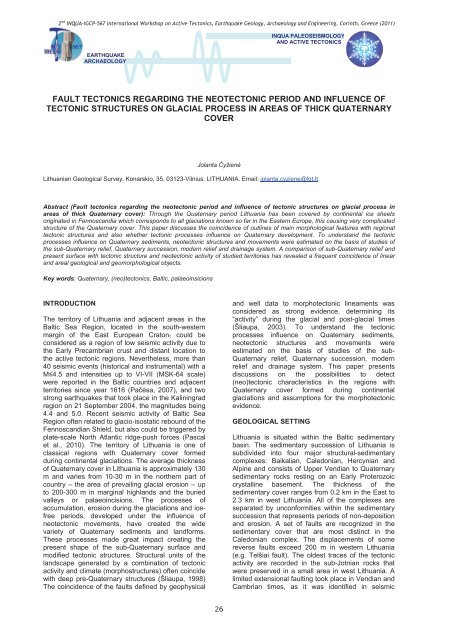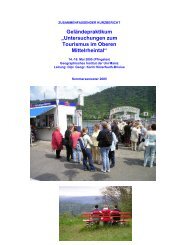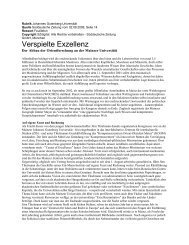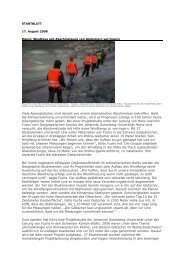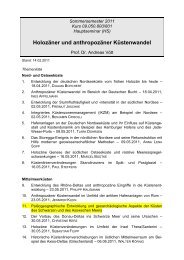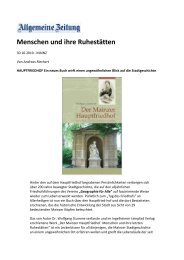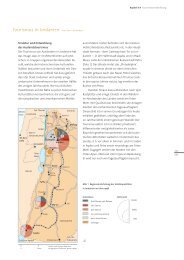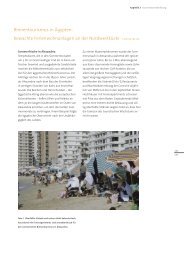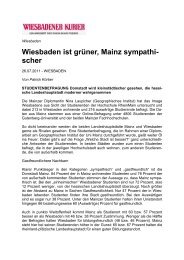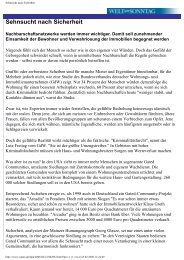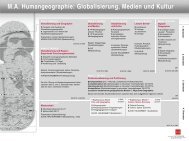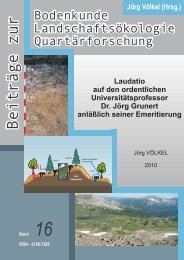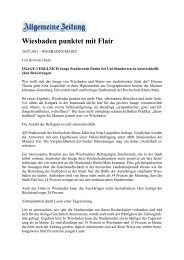Proceedings - Johannes Gutenberg-Universität Mainz
Proceedings - Johannes Gutenberg-Universität Mainz
Proceedings - Johannes Gutenberg-Universität Mainz
Create successful ePaper yourself
Turn your PDF publications into a flip-book with our unique Google optimized e-Paper software.
2 nd INQUA-IGCP-567 International Workshop on Active Tectonics, Earthquake Geology, Archaeology and Engineering, Corinth, Greece (2011)<br />
EARTHQUAKE<br />
ARCHAEOLOGY<br />
INQUA PALEOSEISMOLOGY<br />
AND ACTIVE TECTONICS<br />
FAULT TECTONICS REGARDING THE NEOTECTONIC PERIOD AND INFLUENCE OF<br />
TECTONIC STRUCTURES ON GLACIAL PROCESS IN AREAS OF THICK QUATERNARY<br />
COVER<br />
Jolanta yžien<br />
Lithuanian Geological Survey. Konarskio, 35. 03123-Vilnius. LITHUANIA. Email: jolanta.cyziene@lgt.lt<br />
Abstract (Fault tectonics regarding the neotectonic period and influence of tectonic structures on glacial process in<br />
areas of thick Quaternary cover): Through the Quaternary period Lithuania has been covered by continental ice sheets<br />
originated in Fennoscandia which corresponds to all glaciations known so far in the Eastern Europe, this causing very complicated<br />
structure of the Quaternary cover. This paper discusses the coincidence of outlines of main morphological features with regional<br />
tectonic structures and also whether tectonic processes influence on Quaternary development. To understand the tectonic<br />
processes influence on Quaternary sediments, neotectonic structures and movements were estimated on the basis of studies of<br />
the sub-Quaternary relief, Quaternary succession, modern relief and drainage system. A comparison of sub-Quaternary relief and<br />
present surface with tectonic structure and neotectonic activity of studied territories has revealed a frequent coincidence of linear<br />
and areal geological and geomorphological objects.<br />
Key words: Quaternary, (neo)tectonics, Baltic, palaeoinsicions<br />
INTRODUCTION<br />
The territory of Lithuania and adjacent areas in the<br />
Baltic Sea Region, located in the south-western<br />
margin of the East European Craton, could be<br />
considered as a region of low seismic activity due to<br />
the Early Precambrian crust and distant location to<br />
the active tectonic regions. Nevertheless, more than<br />
40 seismic events (historical and instrumental) with a<br />
M4.5 and intensities up to VI-VII (MSK-64 scale)<br />
were reported in the Baltic countries and adjacent<br />
territories since year 1616 (Pasa, 2007), and two<br />
strong earthquakes that took place in the Kaliningrad<br />
region on 21 September 2004, the magnitudes being<br />
4.4 and 5.0. Recent seismic activity of Baltic Sea<br />
Region often related to glacio-isostatic rebound of the<br />
Fennoscandian Shield, but also could be triggered by<br />
plate-scale North Atlantic ridge-push forces (Pascal<br />
et al., 2010). The territory of Lithuania is one of<br />
classical regions with Quaternary cover formed<br />
during continental glaciations. The average thickness<br />
of Quaternary cover in Lithuania is approximately 130<br />
m and varies from 10-30 m in the northern part of<br />
country – the area of prevailing glacial erosion – up<br />
to 200-300 m in marginal highlands and the buried<br />
valleys or palaeoincisions. The processes of<br />
accumulation, erosion during the glaciations and icefree<br />
periods, developed under the influence of<br />
neotectonic movements, have created the wide<br />
variety of Quaternary sediments and landforms.<br />
These processes made great impact creating the<br />
present shape of the sub-Quaternary surface and<br />
modified tectonic structures. Structural units of the<br />
landscape generated by a combination of tectonic<br />
activity and climate (morphostructures) often coincide<br />
with deep pre-Quaternary structures (Šliaupa, 1998)<br />
The coincidence of the faults defined by geophysical<br />
and well data to morphotectonic lineaments was<br />
considered as strong evidence, determining its<br />
“activity” during the glacial and post-glacial times<br />
(Šliaupa, 2003). To understand the tectonic<br />
processes influence on Quaternary sediments,<br />
neotectonic structures and movements were<br />
estimated on the basis of studies of the sub-<br />
Quaternary relief, Quaternary succession, modern<br />
relief and drainage system. This paper presents<br />
discussions on the possibilities to detect<br />
(neo)tectonic characteristics in the regions with<br />
Quaternary cover formed during continental<br />
glaciations and assumptions for the morphotectonic<br />
evidence.<br />
GEOLOGICAL SETTING<br />
Lithuania is situated within the Baltic sedimentary<br />
basin. The sedimentary succession of Lithuania is<br />
subdivided into four major structural-sedimentary<br />
complexes: Baikalian, Caledonian, Hercynian and<br />
Alpine and consists of Upper Vendian to Quaternary<br />
sedimentary rocks resting on an Early Proterozoic<br />
crystalline basement. The thickness of the<br />
sedimentary cover ranges from 0.2 km in the East to<br />
2.3 km in west Lithuania. All of the complexes are<br />
separated by unconformities within the sedimentary<br />
succession that represents periods of non-deposition<br />
and erosion. A set of faults are recognized in the<br />
sedimentary cover that are most distinct in the<br />
Caledonian complex. The displacements of some<br />
reverse faults exceed 200 m in western Lithuania<br />
(e.g. Telšiai fault). The oldest traces of the tectonic<br />
activity are recorded in the sub-Jotnian rocks that<br />
were preserved in a small area in west Lithuania. A<br />
limited extensional faulting took place in Vendian and<br />
Cambrian times, as it was identified in seismic<br />
26


